(1) It is conceivable that the White and the Black should be juxtaposed in quantities so minute that [a particle of] either separately would be invisible, though the joint product [of two particles, a black and a white] would be visible; and that they should thus have the other colours for resultants. Their product could, at all events, appear neither white nor black; and, as it must have some colour, and can have neither of these, this colour must be of a mixed character- in fact, a species of colour different from either. Such, then, is a possible way of conceiving the existence of a plurality of colours besides the White and Black; and we may suppose that [of this 'plurality'] many are the result of a [numerical] ratio; for the blacks and whites may be juxtaposed in the ratio of 3 to 2 or of 3to 4, or in ratios expressible by other numbers; while some may be juxtaposed according to no numerically expressible ratio, but according to some relation of excess or defect in which the blacks and whites involved would be incommensurable quantities; and, accordingly, we may regard all these colours [viz. all those based on numerical ratios] as analogous to the sounds that enter into music, and suppose that those involving ****** numerical ratios, like the concords in music, may be those generally regarded as most agreeable; as, for example, purple, crimson, and some few such colours, their fewness being due to the same causes which render the concords few. The other compound colours may be those which are not based on numbers. Or it may be that, while all colours whatever [except black and white] are based on numbers, some are regular in this respect, others irregular; and that the latter [though now supposed to be all based on numbers], whenever they are not pure, owe this character to a corresponding impurity in [the arrangement of]
their numerical ratios. This then is one conceivable hypothesis to explain the genesis of intermediate colours.
(2) Another is that the Black and White appear the one through the medium of the other, giving an effect like that sometimes produced by painters overlaying a less vivid upon a more vivid colour, as when they desire to represent an object appearing under water or enveloped in a haze, and like that produced by the sun, which in itself appears white, but takes a crimson hue when beheld through a fog or a cloud of smoke. On this hypothesis, too, a variety of colours may be conceived to arise in the same way as that already described;for between those at the surface and those underneath a definite ratio might sometimes exist; in other cases they might stand in no determinate ratio. To [introduce a theory of colour which would set all these hypotheses aside, and] say with the ancients that colours are emanations, and that the visibility of objects is due to such a cause, is absurd. For they must, in any case, explain sense-perception through Touch; so that it were better to say at once that visual perception is due to a process set up by the perceived object in the medium between this object and the sensory organ; due, that is, to contact [with the medium affected,] not to emanations.
If we accept the hypothesis of juxtaposition, we must assume not only invisible magnitude, but also imperceptible time, in order that the succession in the arrival of the stimulatory movements may be unperceived, and that the compound colour seen may appear to be one, owing to its successive parts seeming to present themselves at once.
On the hypothesis of superposition, however, no such assumption is needful: the stimulatory process produced in the medium by the upper colour, when this is itself unaffected, will be different in kind from that produced by it when affected by the underlying colour. Hence it presents itself as a different colour, i.e. as one which is neither white nor black. So that, if it is impossible to suppose any magnitude to be invisible, and we must assume that there is some distance from which every magnitude is visible, this superposition theory, too [i.e.
as well as No. 3 infra], might pass as a real theory of colour-mixture. Indeed, in the previous case also there is no reason why, to persons at a distance from the juxtaposed blacks and whites, some one colour should not appear to present itself as a blend of both. [But it would not be so on a nearer view], for it will be shown, in a discussion to be undertaken later on, that there is no magnitude absolutely invisible.
(3) There is a mixture of bodies, however, not merely such as some suppose, i.e. by juxtaposition of their minimal parts, which, owing to [the weakness of our] sense, are imperceptible by us, but a mixture by which they [i.e. the 'matter' of which they consist] are wholly blent together by interpenetration, as we have described it in the treatise on Mixture, where we dealt with this subject generally in its most comprehensive aspect. For, on the supposition we are criticizing, the only totals capable of being mixed are those which are divisible into minimal parts, [e.g. genera into individuals] as men, horses, or the [various kinds of] seeds. For of mankind as a whole the individual man is such a least part; of horses [as an aggregate] the individual horse. Hence by the juxtaposition of these we obtain a mixed total, consisting [like a troop of cavalry] of both together;but we do not say that by such a process any individual man has been mixed with any individual horse. Not in this way, but by complete interpenetration [of their matter], must we conceive those things to be mixed which are not divisible into minima; and it is in the case of these that natural mixture exhibits itself in its most perfect form.
We have explained already in our discourse 'On Mixture' how such mixture is possible. This being the true nature of mixture, it is plain that when bodies are mixed their colours also are necessarily mixed at the same time; and [it is no less plain] that this is the real cause determining the existence of a plurality of colours- not superposition or juxtaposition. For when bodies are thus mixed, their resultant colour presents itself as one and the same at all distances alike; not varying as it is seen nearer or farther away.
Colours will thus, too [as well as on the former hypotheses], be many in number on account of the fact that the ingredients may be combined with one another in a multitude of ratios; some will be based on determinate numerical ratios, while others again will have as their basis a relation of quantitative excess or defect not expressible in integers. And all else that was said in reference to the colours, considered as juxtaposed or superposed, may be said of them likewise when regarded as mixed in the way just described.
Why colours, as well as savours and sounds, consist of species determinate [in themselves] and not infinite [in number] is a question which we shall discuss hereafter.















